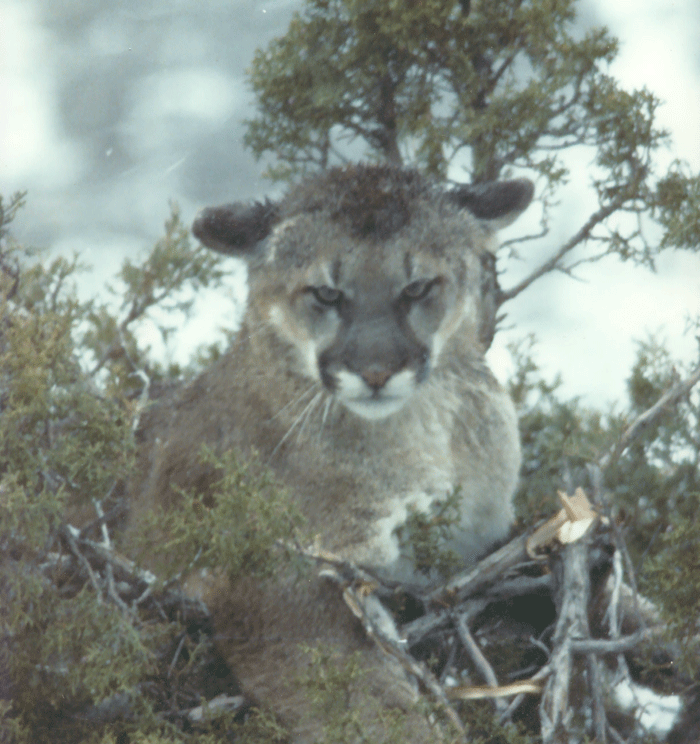The Adirondack Park program of the Wildlife Conservation Society (WCS) published a new report about public attitudes towards cougars (Puma concolor) in the Adirondack Park. WCS is the preeminent wildlife research organization in the U.S. and the Adirondack program is a source of terrific research.
Here’s the link to the whole study Cougar in the Adirondack Park: Resident and Visitor Perspectives.
The report’s authors states that WCS looked at the issue of cougar sightings as part of the Adirondack Atlas project in the late 1990s. They state “While we were able to dismiss many accounts and others seemed to appear clustered in time or space as one might imagine a released individual mountain lion’s activities, some very plausible reports remained. In 2011, a mountain lion hit by a car in Milford, Connecticut, was identified as the same individual from a population in South Dakota. Ultimately we learned this individual also traveled through the Adirondacks. This begs the question: if one can make it, why not more?”
Cougars have made comebacks in many parts of the U.S. over the past 10 years. They have never disappeared from the Rocky Mountain west, yet have colonized many parts of California and have moved in the Dakotas. The cougar population across the U.S. is the largest today than at any time over the last 100 years.
Protect the Adirondacks has been collecting public sightings of cougars in the Adirondack Park in our Cougar Watch project. See our first update of collected sightings.
There is good evidence that cougars have travelled through the Adirondack Park. While there are many reports of sightings there has been no evidence of a resident population or of any cougar births in the Adirondack Park. Yet, given the backdrop of cougar recovery and expansion in the west, WCS saw the time as right to look at the question of public support for cougars in the Adirondack Park. The authors state: “Given the patterns of carnivore recovery – particularly that of mountain lions – ongoing elsewhere across the country, we decided to take a pro-active approach to the potential return of mountain lions to the Adirondack landscape. We chose to pursue a human dimensions study to provide a preliminary understanding of Adirondack residents’ and visitors’ perceptions of possible natural recolonization of mountain lions in northern New York. We see this study as providing a baseline of data by which we can work with state agencies to consider proactive outreach about mountain lions in the region, providing a comparison point to perceptions in some future time should mountain lions establish a population. Living with carnivores in close proximity in the highly populated eastern United States is something new, something different, and not without challenges.”
“Many people in both polls supported the idea of mountain lions returning to the Adirondacks,
either on their own or with human assistance, and there is at least some evidence that greater
public information about mountain lions could increase or solidify these numbers. However, these
positive attitudes may not translate into meaningful behaviors like voting or advocacy (McCleery
et al. 2006). Still, this could be a place where interested groups and agencies could make an
intervention to improve the knowledge-base of the community about these complicated animals.
Additionally, further studies of advocacy groups and others who would be likely to be the key
actors in gaining support for or against a government action would be helpful in understanding
whether such programs would be likely to get a lot of attention from influential organizations on either side (McCleery et al. 2006).
As there are no current plans for mountain lion restoration, the attitudes found here may respond to new information and change over time. Greater specificity about the different types of possible management intervention and a larger-scale, randomized survey of residents of both the Adirondacks and surrounding states and provinces would be needed before any action based on
the preliminary findings of this report should be considered. Such a study across the northeastern United States and surrounding Maritime Provinces in Canada could be used to develop large-scale landscape management strategies for cougars in eastern North America. WCS’s work to restore and maintain wildlife connectivity across the northeastern United States provides a framework that could be used to share information between wildlife managers and NGOs about the
implications of mountain lion restoration in the region.
This study presents compelling evidence for the need to study the human and ecological aspects of mountain lion restoration in the Adirondack Park. Mountain lions, among many other
historically-persecuted carnivores, are naturally recovering their population and range in many
parts of the United States. Although we do not yet have a population in the Adirondacks, it is
possible that there may be one in the future without human intervention. That such a large
percentage of people in this survey were interested in some form of human assistance in mountain
lion restoration suggests that wildlife managers seriously consider the ecological and social
feasibility of interventions that could make restoration more likely. It may be only a matter of
time before this symbol of the wilderness finds its way home to the forever wild forests of the
Adirondacks.”






